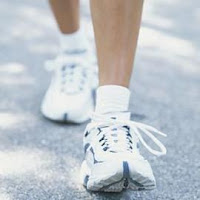If you play a sport three or more times per week, a sport-specific shoe may be necessary. Remember that after 300-500 miles of running, or 300 hours of aerobic activity, the cushioning material in the shoe is usually worn down and it's time to toss the shoes.
Also, before you begin your quest of buying new shoes, contact us and set up a shoe sizing consult. Your one click away. (click the highlighted link to contact us)
- Running Shoes -
Joggers should wear a shoe with more cushioning impact. Running shoes are designed to provide maximum overall shock absorption for the foot. Such a shoe should also have good heel control. Although not a cure-all, these qualities in a running/sports shoe help to prevent shin splints, tendinitis, heel pain, stress fractures, and other overuse syndromes.
- Walking Shoes -
If walking is your sport or your doctor's recommendation for cardiovascular conditioning, wear a lightweight shoe. Look for extra shock absorption in the heel of the shoe and especially under the ball of the foot (the metatarsal area). This will help reduce heel pain (plantar fasciitis and pump bumps) as well as burning and tenderness in the ball of the foot. A shoe with a slightly rounded sole or "rocket bottom" also helps to smoothly shift weight from the heel to the toes while decreasing the forces across the foot. Walking shoes have more rigidity in the front so you can roll off your toes rather than bend through them as you do with running shoes.
- Training Shoes -
Shoes for aerobic conditioning should be lightweight to prevent fatigue and have extra shock absorption in the sole beneath the ball of the foot (metatarsal area) where the most stress occurs. If possible, workout on a carpet.
WAIT!! Before you go any further please make sure to check out our Top Shoe List Brochure online! (Click Here)
- Tennis Shoes -
Tennis players need a shoe that supports the foot during quick side to side movements or shifts in weight. A shoe that provides stability on the inside and outside of the foot is an important choice. Flexibility in the sole beneath the ball of the foot allows repeated quick forward movements for a fast reaction at the net. You need slightly less shock absorption in the shoe if you're playing tennis or other raquet sports. On soft courts, wear a softer soled shoe that allows better traction. On hard courts, you want a sole with greater tread.
- Basketball Shoes -
If basketball is your sport, choose a shoe with a thick, stiff sole. This gives an extra stability when running on the court. A high-top shoe provides support when landing from a jump and may help prevent ankle sprains.
- Cross Trainers -
Cross-training shoes combine several of the above features so that you can participate in more than one sport. A good cross trainer should have the flexibility in the forefoot, for running and combined with the lateral control necessary for aerobics or tennis.
You do not necessarily need a different pair of shoes for every sport in which you participate. Generally, you should wear sport-specific shoes for sports you play more than three times a week. If you have worked our for some time injury-free, then stick with the particular shoes you have been wearing. There is really no reason to chage.
For special problems, you may need a special shoe. A well-cushioned shoe may not be a good shoe for someone who overpronates. If your ankles turn easily, you may need to wear a shoe with a wide heel. If you have trouble with shin splints, you may need a shoe with better shock absorption.
- Shoefit -
The best degsigned shoes in the world will not do their job if they do not fit properly. You can avoid foot problems by finding a shoe store that employs a pedorthist or professional shoe fitter who knows about the different shapes and styles of shoes. Or, you can become an informed consumer and follow these guidelines:
- Dont go just by looks or size. Have your feet measured here at Dr. Vail's.
- Visit our office at the end of a workout when your feet are the largest.
The TOM-CAT Scanner is a safe, accurate and clean system that replaces traditional methods of prescribing orthotics. This method is what we use in the office for our patients. This revolutionary method eliminates the human-error factor, often encountered with traditional casting methods. The TOM-CAT allows patients the ability to consult with their practitioner, have their feet scanned and then be on their way.
The TOM-CAT Scanner is a safe, accurate and clean system that replaces traditional methods of prescribing orthotics. This method is what we use in the office for our patients. This revolutionary method eliminates the human-error factor, often encountered with traditional casting methods. The TOM-CAT allows patients the ability to consult with their practitioner, have their feet scanned and then be on their way.











No comments:
Post a Comment